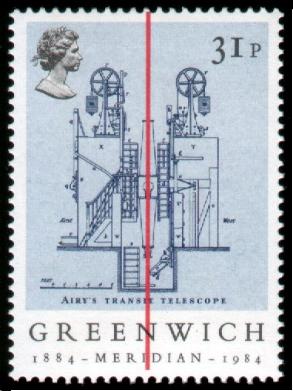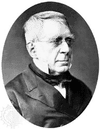 deutsche Version
deutsche Version| Manfred Börgens Mathematics on stamps |
stamp list previous stamp next stamp |
main page |
 deutsche Version deutsche Version |
 |
Great Britain 1984 Scott 1061 |
Airy's telescope in the Greenwich Royal Observatory
This stamp is taken from a set of four issued on the centenary of the official recognition of the Greenwich meridian as international reference meridian.
In 1880, Great Britain introduced a common legal time: Greenwich Mean Time (GMT). It was defined as the local time of Greenwich, a London borough. More precisely, GMT is the average sun time for a definite meridian going through Greenwich (taking the average is necessary because the days of a year have different lengths from true noon to true noon). This meridian was marked in the Greenwich Royal Observatory. Four years later, an international conference declared it the worldwide accepted standard meridian (0°). Since then, all longitudes on earth are defined in relation to the Greenwich meridian, and all time zones are defined by their difference from GMT.
George Biddell Airy (1801 - 1892)
G. B. Airy was born on 27th July 1801. His name can be seen on the stamp, together with the telescope he built in Greenwich.
Airy studied in Cambridge and became Fellow of Trinity College. He was the best mathematician of his year and was appointed to the Lucasian Chair at the age of 25. Isaac Newton had held this chair, now Stephen Hawking is holding it. From 1835 to 1881, Airy held the position of Astronomer Royal. His extensive work includes books and articles on mathematics, astronomy, physics und geography. Crater Airy on Mars honours his name; the position of this crater is exactly on the 0° Mars meridian.

George Biddell Airy
Mathematicians und physicists know Airy's differential equation

and its solution

Airy's telescope
In 1850, Airy built the Transit telescope at the observatory in Greenwich. Its designs are shown on the stamp. It was used to measure exactly the transit times of planets and stars through the 0° meridian - the red line on the stamp symbolizes this meridian. Airy's telescope is still working in the Royal Observatory, now part of the National Maritime Museum.
Airy and Babbage
One may feel that Airy's reputation is shadowed by his attitude towards Charles Babbage. Airy argued successfully against further governmental support for Babbage's Difference Engine and thus held up the progress of computer science in England.
George Biddell Airy